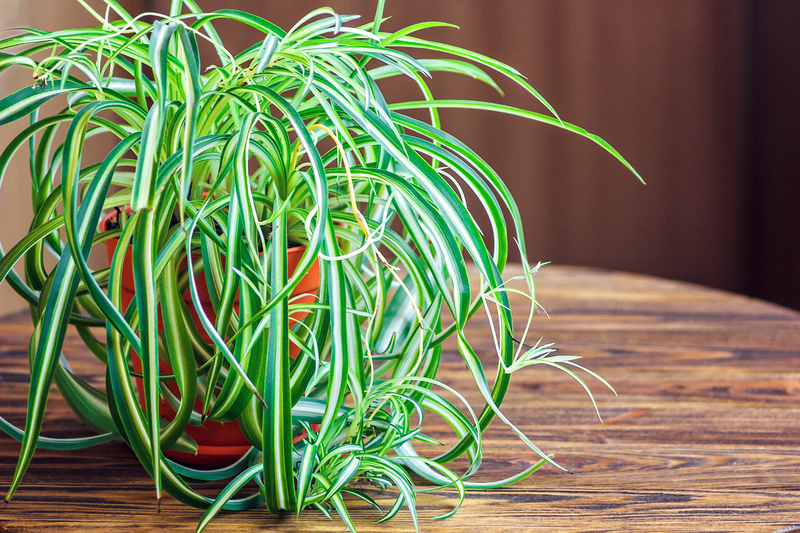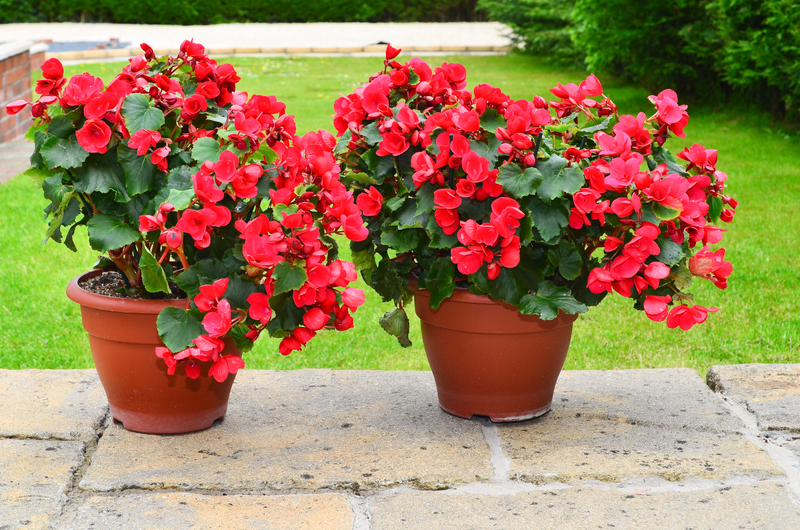The Art and Science of Container Gardening
Posted on 16/06/2025
The Art and Science of Container Gardening: A Comprehensive Guide
Introduction to the Magic of Container Gardening
Container gardening has emerged as a revolutionary way for urban dwellers, suburban homeowners, and even rural residents to enjoy the beauty and bounty of plants without requiring vast spaces of land. Whether you are working with a tiny balcony, a sunny windowsill, or a sprawling patio, the art and science of container gardening offers endless creative and practical possibilities. This in-depth guide explores methods, tips, and inspiration to help garden enthusiasts of every level nurture thriving plants in pots, baskets, and creative vessels.

Why Choose Container Gardening?
Modern living often means limited access to traditional garden spaces. Fortunately, container gardening brings greenery--and the joys of growing--within everyone's reach. Here's why more people are choosing to cultivate their plants in containers:
- Flexibility: Rearrange your garden with ease; move plants for optimum sunlight or aesthetic effect.
- Versatility: Grow vegetables, herbs, flowers, even small trees, regardless of your square footage.
- Accessibility: Ideal for gardeners with limited mobility or physical challenges, as containers can be raised to a comfortable working height.
- Control: Regulate soil quality, drainage, pests, and diseases more effectively than in-ground beds.
- Seasonal Variety: Easily swap out plants to create year-round interest.
Choosing the Right Containers
Mastering the art of container gardening starts with selecting the right vessels for your plants. From classic terra cotta pots to upcycled barrels, your choice impacts both aesthetics and plant health. Consider the following factors:
Material Matters
- Clay/Terracotta: Breathable, classic, but can dry out quickly and break in freezing temperatures.
- Plastic: Lightweight, affordable, and retains moisture well.
- Ceramic/Glazed: Decorative, durable, but can be heavy and may not have adequate drainage.
- Metal: Sleek and modern, but may heat up and damage roots in direct sun.
- Wood: Natural look, good insulation for roots, but can rot over time without proper care.
- Fabric/Grow Bags: Excellent for root health and easy to move, though they may dry out quicker.
Size and Drainage
Size matters in container gardening! Choose pots large enough to accommodate root growth and allow for adequate soil volume, which helps retain moisture and nutrients. Proper drainage holes are essential to prevent root rot and overwatering. Adding a layer of gravel or broken pottery at the base can improve drainage.
The Science of Soil in Container Gardening
Unlike garden beds, container plants rely 100% on what you put in their container. Getting the soil mix right is critical for healthy, vibrant plants.
Building the Perfect Potting Mix
- Soil-less Mixes: Most container garden aficionados prefer soilless mixes of peat moss, coir, perlite, and vermiculite for optimal drainage and aeration.
- Compost: Incorporates organic matter, provides slow-release nutrients, enhances microbial activity.
- Avoid Garden Soil: Heavy and may carry pests or diseases that can overwhelm containers.
- Specialty Mixes: Use cactus mix for succulents or acid-loving mixes for blueberries, azaleas.
Tip: Refresh or replace your potting mix every season due to depletion of nutrients and compaction.
Essential Elements: Sun, Water, and Nutrition
To perfect container gardening, understanding how sunlight, water, and fertilization interact is vital. These elements must be carefully monitored, as containers are more vulnerable to fluctuations.
Light Right: Matching Plants to Place
- Full Sun: Tomatoes, peppers, and zinnias thrive best in 6+ hours of direct sun.
- Partial Shade: Herbs like mint and parsley, impatiens, and ferns prefer less intense light.
- Full Shade: Think hostas, snake plant, or peace lilies for those shadowy corners.
Rotate containers regularly to ensure balanced growth and shape.
Mastering Watering Techniques
- Check soil moisture daily; containers dry out faster than ground beds.
- Water early in the day to minimize evaporation.
- Use self-watering pots or drip irrigation for larger arrangements.
- Avoid overwatering! Roots rot easily in standing water. Let the soil dry out slightly between waterings.
Feeding for Vigorous Growth
- Use a balanced liquid fertilizer every 2-4 weeks, or choose slow-release pellets mixed into the soil.
- Organic options like fish emulsion or compost tea promote strong growth without chemical buildup.
- Monitor for deficiencies: Yellowing leaves, weak stems, or poor blooming can signal a lack of nutrients.
Best Plants for Container Gardening
The joy of container gardening is in its boundless choice of plants. From flowers to food, your containers can become miniature landscapes, designed for beauty, utility, or both.
Edible Container Garden Ideas
- Herbs: Basil, parsley, thyme, mint, rosemary--these aromatic favorites thrive in pots inside or out.
- Salad Greens: Lettuce, spinach, arugula, kale--pick fresh at your fingertips.
- Vegetables: Tomatoes, peppers, eggplants, radishes, bush beans--all adaptable to large pots or grow bags.
- Fruits: Strawberries, blueberries, dwarf citrus, and figs do exceptionally well in containers with the right care.
Ornamental Container Plants
- Annuals: Petunias, geraniums, marigolds, and impatiens for pops of color all season long.
- Perennials: Hostas, daylilies, and heucheras provide longer-lasting structures.
- Foliage: Ferns, ornamental grasses, coleus, and caladium create texture and drama.
- Succulents & Cacti: Require specialty soils but reward with unique forms and minimal water needs.
Designing Your Container Garden: The Artistic Touch
The art of container gardening transforms practical plant care into a visual feast. Whether you prefer sleek modern arrangements or lush cottage charm, design principles help you make the most of your space.
Design Basics for Containers
- Thriller-Spiller-Filler: Combine a tall focal plant ("thriller"), cascading varieties around the edges ("spiller"), and mounding fillers for a balanced look.
- Color Harmony: Use complementary or analogous colors for a harmonious effect, or go wild with bold contrasts.
- Texture and Form: Mix broad leaves with airy grasses, spiky forms with rounded blooms.
- Groupings: Cluster pots of different sizes and styles for a more dynamic garden.
- Verticality: Incorporate trellises, hanging baskets, or stacked pots to maximize small spaces.
Don't forget personal touches: painted pots, unique vintage containers, and garden art elevate your container garden into a personal statement.
Seasonal Success: Year-Round Container Gardening
The science of container gardening allows you to enjoy plants through every season.
Spring Into Action
- Start early with hardy pansies, violas, and cold-tolerant greens in March or April.
Summer Splendor
- Plant heat lovers like geraniums, petunias, tomatoes, or peppers.
- Monitor daily for water needs during hot spells.
Autumn Warmth
- Swap tender summer blooms for mums, ornamental cabbages, and grasses to extend color into fall.
Winter Wonders
- Plant evergreens, hardy heathers, or ornamental kale in frost-resistant pots for cold-weather interest.
- Bring tender plants indoors to protect from frost.
Pest and Disease Management in Container Gardens
One advantage of container gardening is the ability to isolate and treat affected plants more quickly than in open beds. Here are some smart ways to keep your potted paradise healthy:
- Inspect plants regularly for pests like aphids, spider mites, and snails.
- Use manual removal, neem oil, or insecticidal soap for infestations.
- Ensure good air circulation to prevent fungal diseases like powdery mildew.
- Avoid overcrowding plants, which can attract pests and promote disease.
- Sanitize containers between seasons to prevent carry-over of pathogens.
Eco-Friendly Container Gardening Tips
- Use organic fertilizers and pest controls whenever possible.
- Collect rainwater for irrigation to conserve resources.
- Repurpose containers: Upcycle old buckets, crates, boots, and even bathtubs for plantings.
- Compost spent soil and dead plant matter for future use.
- Choose native plants for low-maintenance, wildlife-friendly pots.
Common Troubleshooting in Container Gardening
- Wilting Leaves: Often caused by under- or overwatering. Check soil moisture and drainage.
- Pale Leaves or Weak Growth: May signal a need for fertilizing or more light.
- Moldy Soil: Indicates excess moisture; improve drainage and water less frequently.
- Root Bound Plants: When roots fill the pot and growth stalls, repot into a bigger container.
- Pests/Disease: Isolate affected plants and use suitable organic treatments.
The Rewards of Container Gardening
The art and science of container gardening blend creativity and knowledge, empowering anyone to cultivate their own piece of paradise. From the satisfaction of fresh-picked herbs to the visual delight of blooming arrangements, the rewards are plentiful:
- Personal connection to nature, even in urban environments
- Therapeutic benefits for mental and emotional well-being
- Fresh, homegrown produce all year round
- Aesthetic improvements to indoor and outdoor spaces
- An ever-evolving hobby that grows along with you

Conclusion: Start Your Container Garden Journey Today
Whether you're a seasoned horticulturist or a novice plant lover, embracing the art and science of container gardening can transform spaces and lives. Each pot is a blank canvas--an opportunity to experiment, express, and grow. With these comprehensive insights and practical tips, your container gardening adventure awaits. So grab a pot, select a plant, and let your creativity take root!
Frequently Asked Questions
- Can I grow vegetables in small containers? Yes! Many vegetables, including cherry tomatoes, peppers, and lettuce, thrive in compact pots. Just ensure adequate sunlight and water.
- How often should I water my container plants? Most pots need daily watering during warm weather, but always check soil moisture first. Overwatering is as harmful as neglect.
- Which containers work best for balcony gardens? Lightweight plastic, fabric bags, and railing planters are excellent for balconies. Choose shapes and materials that suit your space and climate.
Ready to unlock the full potential of your space? Explore the fascinating world of container gardening today!

